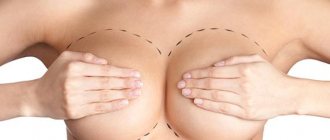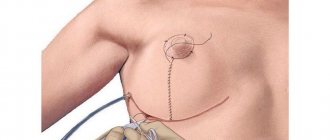Breast lift (mastopexy) is an operation aimed at creating a normal position of the mammary gland and nipple-areolar complex by eliminating ptosis (drooping) of the tissue. Breast ptosis develops against the background of sudden changes in weight, after lactation, as a result of natural aging processes, hormonal disorders, and also under the influence of gravitational forces. Most women over 30 years old experience mastoptosis. Women with breast volume “C” or more, as well as a weak skin framework (lack of collagen and elastin in the dermis), are at risk. Dissatisfaction with breasts affects the general psychological state and often becomes the cause of sexual problems. Often, breast drooping is accompanied by pronounced asymmetry and an increase in the diameter of the areolas, which aggravates the overall appearance.
The following mastopexy techniques are used in clinical practice:
- periareolar breast lift (circular, circular) - incision around the areola
- vertical breast lift – tissue dissection from the upper pole of the areola to the base of the breast
- anchor breast lift (T-shaped) – an incision around the areola, perpendicular to the base of the breast and along the inframammary fold
Endoscopic lifting (access through skin punctures), as well as other alternative surgical techniques that involve correction of the shape and volume of the mammary glands through endoprosthetics (installation of implants).
The choice of mastopexy technique depends on the indications and wishes of the patient. When determining the mastopexy technique, the surgeon evaluates the degree of mastoptosis, the location of the gland relative to the chest wall, and the condition of the tissues (elasticity, skin thickness). If necessary, breast lift is combined with increasing (augmentation) or decreasing (reduction) mammoplasty.
Preparing for mastopexy
Regardless of the mastopexy technique, the patient undergoes standard diagnostics before the operation. Preoperative diagnosis includes the following tests:
- clinical blood test, urine test
- biochemical blood test
- blood for infections, group and Rh factor
- blood clotting test
It is necessary to obtain a written opinion from a physician about the general state of health and the absence of diseases that can cause complications (diabetes mellitus, condition after myocardial infarction). Instrumental diagnostics include:
- electrocardiography
- fluorography
- mammography
The patient is also examined by an anesthesiologist, who calculates the optimal dose of drugs for anesthesia.
A week before plastic surgery, it is necessary to avoid drinking alcoholic beverages, smoking, physical and psychological stress, inform the surgeon about taking any medications, and if necessary, stop taking medications. Before surgery, you need to eliminate stressful situations in your life.
In order for the preference for a certain technique to be conscious, the patient needs to understand the specifics of the operation. All mastopexy techniques that deserve attention are described in this article. Detailed information can be clarified during a consultation with a plastic surgeon.
Don’t put off making your dream of an ideal body come true, call the number listed on the website and make an initial consultation with a plastic surgeon at the ABC Clinic.
Periareolar breast lift
Breast lift along the areola is indicated for minor and moderate ptosis (I-II degree of ptosis) for owners of small and medium breasts (no larger than “C”). In women with breast size “A”, periareolar breast lift is combined with endoprosthetics (installation of implants). It is not advisable to perform a breast lift on women with very small busts as a stand-alone operation. A breast lift through the nipple is carried out after a comprehensive examination and exclusion of contraindications.
A breast lift through the areola requires precise measurement of the woman’s body parameters and markings applied to the skin. In the periareolar region, the surgeon makes a marking in the shape of an ellipse, along the edges of which the tissue incision will be made. After putting the patient into medicated sleep, the surgeon dissects the breast skin around the areola, removes or stitches fragments of deformed tissue and sutures the edges of the wound layer by layer. To prevent subsequent ptosis and prolong the positive effect, the surgeon fixes the upper pole of the gland at the level of the third rib using self-absorbable suture material.
At the last stage, the sutured edges of the wound are covered with a sterile bandage, and the doctor puts an elastic bandage bra on you.
Circular breast lift is the least traumatic technique. But to avoid complications, you should strictly follow all the rules of rehabilitation prescribed by your doctor. A periareolar breast lift takes on average 60 minutes.
Possible risks
All potential patients are interested in the risk level of a breast lift. Already at the first interview, the doctor must provide complete and reliable information about the presence of possible side effects. Practice shows that the vast majority of operations take place without serious complications. In rare cases, bleeding, an inadequate reaction of the body to anesthesia, infection and inflammatory processes were detected. If such symptoms appear, you should immediately consult a doctor. This category of risks is usually associated with the quality of the operation performed. That is why you should choose a trusted clinic and an experienced plastic surgeon.
Another category of problems involves recurrent ptosis. If the original causes remain, then this possibility cannot be excluded. Most often, they are associated with fluctuations in body weight, hormonal disorders and breast volume. These risks should be taken into account by the woman herself, eliminating the causes of their occurrence.
Another possible consequence is loss of sensitivity in the nipples. This effect depends on the individual characteristics of the organism. On average, 14-16% of women undergoing surgery experience this phenomenon.
Vertical breast lift
Vertical breast lift allows you to eliminate grade II-III ptosis. This technique is suitable for patients with medium breast sizes. The examination tactics are described in the second section of the article. After marking, premedication and immersion of the patient under anesthesia, the surgeon begins the main stage of the operation. Having processed the surgical field, the doctor dissects the skin along the intended lines, around the areola, down to the submammary fold. Then the nipple-areolar complex is moved higher, excess tissue is excised and the edges of the wound are sutured. The operation takes 1.5-2 hours.
After surgery and rehabilitation, the breasts look natural, the areola is at the top of the breast mound, and the breasts feel natural density. As a result of this method of mastopexy, a vertical scar is left on the skin, which fades and becomes invisible after 6-12 months. The scar around the areola merges with the skin and does not represent a pronounced cosmetic defect. If desired, the scar around the areola can be corrected using tattooing.
Anchor breast lift
T-shaped breast lift is a traumatic and at the same time the most effective method for correcting ptosis of the mammary glands. An anchor breast lift is suitable for those with outstanding shapes. For breast hypertrophy, anchor mastopexy is combined with reduction mammoplasty. During a combined operation, the surgeon excises part of the hypertrophied gland tissue and removes excess skin flaps.
For mastoptosis in patients with BD breast size, anchor plasty can be combined with gland augmentation. The size and shape of implants for augmentation are discussed individually. Preparation for this operation is no different from preparation for other major surgical interventions.
After providing general anesthesia and aseptic treatment of the surgical field, the surgeon begins the procedure. Incisions are made according to preoperative markings. After skin detachment, the fat layer is peeled off, thereby providing access to the glandular tissues. An electrocoagulator is used to stop bleeding from small blood vessels. At the next stage, the glandular structures of the breast are disconnected from the fixation points for further movement higher. The surgeon places guiding sutures, evaluates the preliminary result and begins to apply internal sutures that secure the breast frame. Then cosmetic sutures are applied to adapt the edges of the wounds and promote the formation of minimal scars. The bulk of the time with this type of plastic surgery is spent on cosmetic suturing of the incisions. At the last stage, the color of the skin in the intervention area is assessed for the absence of ischemia (lack of blood circulation) and hematomas (bruises). The operation lasts 2-2.5 hours. The patient leaves the clinic on the day of surgery and comes for the first dressing change a day later.
Post-operative recovery
Mastopexy is a surgical operation, after which rehabilitation of the body is necessary. Within 24 hours after the procedure, the woman must remain in the hospital under the supervision of doctors. Particular attention is paid to the release of their anesthesia. If necessary, a drainage tube is inserted into the mammary gland to remove fluid. Quite often, the postoperative effect is expressed in pain. To eliminate them, painkillers are taken.
If the operation is performed correctly, the patient returns to good health within 2-3 days after the operation, and she can continue her recovery at home. A prerequisite is to wear a special surgical bra (compression stockings). It should be worn for at least 1 month.
The stitches are removed after 13-15 days. Final results can be assessed 2.5-3 months after discharge from the hospital. For 30-40 days, a woman is not allowed to play sports, visit a bathhouse or sauna, or sunbathe on a beach or solarium. Fluctuations in body weight and hormonal changes during the rehabilitation period are extremely undesirable. To ensure this condition, it is recommended to optimize and streamline food intake.
Mastopexy can only be prescribed to girls who have reached the age of majority. You should not schedule a lift before a planned pregnancy, during it or during lactation. In these cases, the effect of the operation is completely unpredictable, because Milk production and hormonal changes have a significant impact and the shape of the breasts will be noticeably affected. Tightening is not recommended before starting the weight loss process or while following a weight loss diet.
Fadin Alexander Sergeevich plastic surgeon, Candidate of Medical Sciences
Endoscopic breast lift and other methods
Endoscopic breast lift involves installing implants through micro-incisions in the skin in natural folds - axillary and submammary. The most common approach for endoscopic mammoplasty is axillary (axillary). Seamless breast lift allows you to achieve an ideal result for stage I ptosis in women with small mammary glands. At the same time, the method is traumatic, since in order to place the implant in the mammary gland area, the skin is peeled off from the armpit to the submammary fold. The surgeon's manipulations are performed under the control of an endoscope - an optical-electronic device in the form of a thin tube that transmits a magnified image from the intervention area on the monitor. After rehabilitation, traces of plastic surgery are not noticeable. Using this technique, it is impossible to eliminate grade II-III ptosis and correct sagging breasts larger than size “B”.
Laser technologies are also used in plastic surgery, the main area of application being the face and neck. Laser breast lift is not suitable for severe ptosis. The purpose of using a laser in the mammary glands is only to polish postoperative scars and stretch marks. Laser breast lift is a cosmetic procedure and is not a mastopexy technique. The laser beam can be used as part of breast replacement to cut tissue in the submammary fold. In this case, the laser knife acts as a scalpel; the advantage of this method is the simultaneous sealing of blood vessels.
You can restore the elasticity of small mammary glands in the initial stages of prolapse using lipofilling (transplantation of your own fat). During the fat grafting procedure, the surgeon removes fat cells from the thighs, abdomen, or other areas of the body where fat deposits are located. After collection, the fat cells are divided into two parts, stem cells are extracted from the first part and added to the second part. Stem-enriched fat cells are injected into the breasts using syringes. Stem cells used during lipofilling increase the survival rate and stability of the transplanted fat cells. To prolong the effect, the procedure must be repeated regularly.
How is the operation performed?
Professor I. A. Bely performs breast correction procedures in Moscow. The total duration of the operation depends on the chosen method and the condition of the tissue. At the preliminary consultation, Igor Anatolyevich will select the appropriate technique for you and tell you in detail how the operation will take place.
Any type of breast lift is performed under general anesthesia using modern painkillers. The extensive practical experience and skill of Professor I. A. Bely will allow you to avoid postoperative complications and ensure quick and comfortable rehabilitation.











